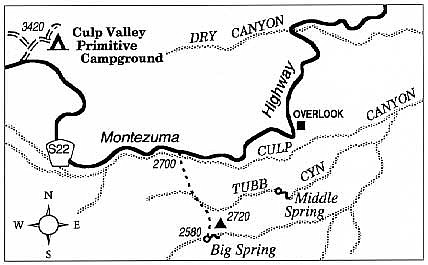 Facebook
Facebook
 X
X
 Instagram
Instagram
 TikTok
TikTok
 Youtube
Youtube
Big Spring, tucked in a tributary of Tubb Canyon on the west side of Borrego Valley, is one of the more reliable water producers in the Anza-Borrego Desert State Park. As such, it is an important watering hole for local wildlife. Tracks on the sandy pathways leading to the spring show evidence of visits by coyotes, mountain lions, and bighorn sheep.
Unknown to most park visitors, Big Spring is quite easy to reach on foot -- only a 3/4-mile walk from the nearest paved road. The best place to start hiking is the small parking turnout on the north side of Montezuma Highway (S-22) at mile 11.2. Remember that you'll need a state-park permit ($5 per day) for parking in Anza-Borrego. Permits are available at the entrance to Culp Valley Campground and down the hill in Borrego Valley at the state-park visitors' center and elsewhere. Bring liquid refreshment with you. Midday temperatures at this elevation are routinely in the 90s this late in the season.
Walk due south across 400 yards of flat terrain, and cross over a gentle saddle. At this point you should pick up a trail that descends into a sandy wash -- the head of Tubb Canyon. After about 200 yards downstream the trail leaves this wash and passes over a low saddle to the south. Big Spring lies beyond, in the bottom of Tubb Canyon's south branch.
At the spring, the water gushes through tall thickets of seepwillow and thorny tangles of catclaw and mesquite -- so it may be hard to reach the water with one's hide intact. Small willows and cottonwoods raise their crowns above it all. Enhancing the scene is the massive presence of Pinyon Ridge, rising to the south.
Before going back to the highway, try climbing the small hill (2720´) east of the saddle you just passed over. This is one of the panoramic viewing sites used by volunteers during the Anza-Borrego Desert summer bighorn-sheep census.


Big Spring, tucked in a tributary of Tubb Canyon on the west side of Borrego Valley, is one of the more reliable water producers in the Anza-Borrego Desert State Park. As such, it is an important watering hole for local wildlife. Tracks on the sandy pathways leading to the spring show evidence of visits by coyotes, mountain lions, and bighorn sheep.
Unknown to most park visitors, Big Spring is quite easy to reach on foot -- only a 3/4-mile walk from the nearest paved road. The best place to start hiking is the small parking turnout on the north side of Montezuma Highway (S-22) at mile 11.2. Remember that you'll need a state-park permit ($5 per day) for parking in Anza-Borrego. Permits are available at the entrance to Culp Valley Campground and down the hill in Borrego Valley at the state-park visitors' center and elsewhere. Bring liquid refreshment with you. Midday temperatures at this elevation are routinely in the 90s this late in the season.
Walk due south across 400 yards of flat terrain, and cross over a gentle saddle. At this point you should pick up a trail that descends into a sandy wash -- the head of Tubb Canyon. After about 200 yards downstream the trail leaves this wash and passes over a low saddle to the south. Big Spring lies beyond, in the bottom of Tubb Canyon's south branch.
At the spring, the water gushes through tall thickets of seepwillow and thorny tangles of catclaw and mesquite -- so it may be hard to reach the water with one's hide intact. Small willows and cottonwoods raise their crowns above it all. Enhancing the scene is the massive presence of Pinyon Ridge, rising to the south.
Before going back to the highway, try climbing the small hill (2720´) east of the saddle you just passed over. This is one of the panoramic viewing sites used by volunteers during the Anza-Borrego Desert summer bighorn-sheep census.
